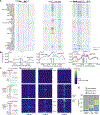Genomic context sensitizes regulatory elements to genetic disruption
- PMID: 38759624
- PMCID: PMC11104518
- DOI: 10.1016/j.molcel.2024.04.013
Genomic context sensitizes regulatory elements to genetic disruption
Abstract
Genomic context critically modulates regulatory function but is difficult to manipulate systematically. The murine insulin-like growth factor 2 (Igf2)/H19 locus is a paradigmatic model of enhancer selectivity, whereby CTCF occupancy at an imprinting control region directs downstream enhancers to activate either H19 or Igf2. We used synthetic regulatory genomics to repeatedly replace the native locus with 157-kb payloads, and we systematically dissected its architecture. Enhancer deletion and ectopic delivery revealed previously uncharacterized long-range regulatory dependencies at the native locus. Exchanging the H19 enhancer cluster with the Sox2 locus control region (LCR) showed that the H19 enhancers relied on their native surroundings while the Sox2 LCR functioned autonomously. Analysis of regulatory DNA actuation across cell types revealed that these enhancer clusters typify broader classes of context sensitivity genome wide. These results show that unexpected dependencies influence even well-studied loci, and our approach permits large-scale manipulation of complete loci to investigate the relationship between regulatory architecture and function.
Keywords: enhancer selectivity; gene regulation; genetic engineering; genome writing; genomic regulatory architecture; synthetic regulatory genomics.
Copyright © 2024 Elsevier Inc. All rights reserved.
Conflict of interest statement
Declaration of interests R.B., J.D.B., and M.T.M. are listed as inventors on a patent application describing Big-IN. Jef Boeke is a founder and director of CDI Labs, Inc.; a founder of and consultant to Opentrons LabWorks/Neochromosome, Inc.; and serves (or served) on the scientific advisory board of the following: CZ Biohub New York, LLC; Logomix, Inc.; Modern Meadow, Inc.; Rome Therapeutics, Inc.; Sangamo, Inc.; Tessera Therapeutics, Inc.; and the Wyss Institute.
Figures




Update of
-
Genomic context sensitizes regulatory elements to genetic disruption.bioRxiv [Preprint]. 2024 Mar 12:2023.07.02.547201. doi: 10.1101/2023.07.02.547201. bioRxiv. 2024. Update in: Mol Cell. 2024 May 16;84(10):1842-1854.e7. doi: 10.1016/j.molcel.2024.04.013. PMID: 37781588 Free PMC article. Updated. Preprint.
References
MeSH terms
Substances
Grants and funding
LinkOut - more resources
Full Text Sources
Molecular Biology Databases
Miscellaneous

